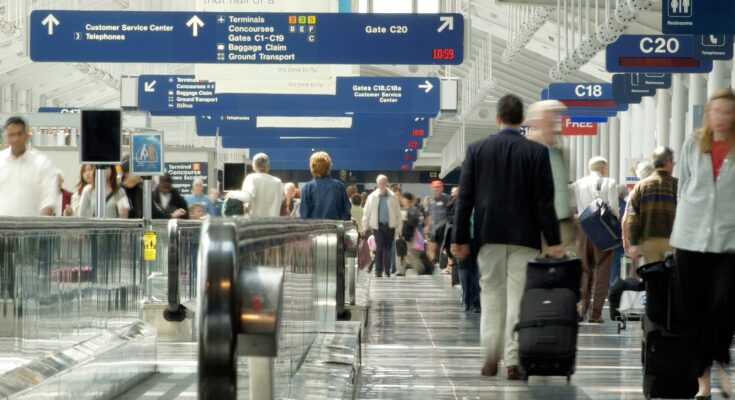Airports are critical infrastructures that connect people, businesses, and cultures across the globe. They serve as gateways for tourism, trade, and economic development, making air travel an essential component of modern life. While every country has at least one international or domestic airport, some nations are home to thousands of airports, ranging from major international hubs to small regional airstrips.
In this post, we’ll explore five countries with the highest number of airports and uncover why air transportation is so prominent in these nations. Whether you’re a frequent flyer, aviation enthusiast, or simply curious about global travel infrastructure, this post will give you valuable insights into the world’s aviation giants.
1. United States—Over 13,000 Airports
Why the U.S. Tops the List
The United States is by far the country with the most airports in the world. According to the Federal Aviation Administration (FAA), the U.S. boasts over 13,000 airports, including public-use, private-use, and military airfields. Of these, about 5,000 are open to public use, while the rest serve private or military purposes.
Several factors contribute to the vast number of airports in the U.S.:
-
Large landmass and diverse geography: From coast to coast, the U.S. spans thousands of miles, making air travel a convenient mode of transport.
-
High demand for domestic flights: The country has a strong domestic air travel market, with millions of people flying daily for business and leisure.
-
Robust general aviation sector: Beyond commercial flights, there’s a high number of private jets, chartered planes, and flying clubs.
Notable Airports
-
Hartsfield–Jackson Atlanta International Airport (ATL)—one of the world’s busiest airports.
-
Los Angeles International Airport (LAX) – Major hub for international travel, especially to Asia and Oceania.
-
Chicago O’Hare International Airport (ORD)—A key connecting airport for both domestic and international flights.
2. Brazil—Over 4,000 Airports
Air Travel as a Lifeline
Brazil is the largest country in South America and has over 4,000 airports, making it the second country in the world with the highest number of airports. The majority of these are small regional or private airstrips, but Brazil also has many major international hubs.
Why So Many Airports?
-
Vast and challenging terrain: The Amazon rainforest and mountainous regions make road and rail travel difficult, increasing reliance on air transport.
-
Remote communities: Many towns and villages can only be accessed quickly by air.
-
Tourism and business: Brazil attracts millions of visitors annually and is a key player in global agriculture and mining industries, which require logistical connectivity.
Major Airports
-
São Paulo/Guarulhos – Governador André Franco Montoro International Airport (GRU) – The busiest airport in Brazil.
-
Brasília International Airport (BSB)—Serves the capital and is a central hub for domestic flights.
3. Mexico—Over 1,700 Airports
A Tourism-Driven Airspace
Mexico has over 1,700 airports, making it one of the top five countries with the most aviation facilities. With a booming tourism industry and a strong regional air network, Mexico’s airports serve both international tourists and domestic travelers.
Reasons for the High Count
-
Tourism hotspots: Locations like Cancun, Mexico City, and Cabo San Lucas require large international airports.
-
Industrial and agricultural zones: The need to move goods efficiently has led to the development of numerous cargo and regional airports.
-
Geography: Mountainous terrain and lengthy coastlines make air travel a faster alternative to road or rail.
Popular Airports
-
Mexico City International Airport (MEX) – One of Latin America’s busiest.
-
Cancún International Airport (CUN) – A major entry point for tourists.
4. Canada – Over 1,400 Airports
Connecting a Vast and Sparsely Populated Nation
Canada, the second-largest country in the world by land area, has over 1,400 airports, making air travel essential for connectivity, especially in its northern territories.
Why Air Travel Is Essential in Canada
-
Remote communities: In provinces like Yukon, Nunavut, and the Northwest Territories, many towns are unreachable by road.
-
Weather and terrain: Harsh winters and vast forests make air travel the most reliable means of transport.
-
Natural resource industries: Mining, oil, and forestry operations often require dedicated airstrips.
Major Canadian Airports
-
Toronto Pearson International Airport (YYZ) – Canada’s busiest and largest airport.
-
Vancouver International Airport (YVR) – A key hub for Pacific travel.
-
Calgary International Airport (YYC) – Vital for Western Canada and energy sector workers.
5. Russia—Over 1,200 Airports
Navigating a Continental-Scale Nation
Russia, the world’s largest country by landmass, has over 1,200 airports, many of which serve remote or isolated areas that are otherwise hard to reach.
Factors Behind Russia’s Airport Count
-
Massive territory: Spanning 11 time zones, Russia requires a dense network of airports.
-
Harsh climate and difficult terrain: In Siberia and the Russian Far East, air travel is often the only viable year-round option.
-
Military and strategic use: Many airports serve dual civilian-military functions due to Russia’s defense infrastructure.
Important Russian Airports
-
Sheremetyevo International Airport (SVO)—The largest airport in Russia, located in Moscow.
-
Pulkovo Airport (LED)—Serves Saint Petersburg and is a major hub for European travel.
From the sprawling airport networks in the United States to the strategic airfields scattered across Russia, the number of airports in a country often reflects its size, geography, population distribution, and economic priorities. Whether for tourism, commerce, emergency response, or daily commuting, these aviation hubs play a vital role in global and national connectivity.



